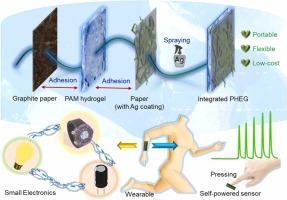集成纸-水凝胶结构,用于自发和超持久的环保发电
IF 17.1
1区 材料科学
Q1 CHEMISTRY, PHYSICAL
引用次数: 0
摘要
基于湿气吸附的能量收集技术是一种很有前途的从环境中利用电力的方法,它作为小型可穿戴电子设备的蓄能器呈现出巨大的潜力。吸水材料的进步推动了可持续水分能源技术的发展。然而,在低湿度环境中,由于湿度水平的变化,保持稳定的产量仍然存在挑战。为了解决这些问题,一种纸-水凝胶发电机(PHEG)被开发出来,该发电机将商用纤维素滤纸和粘接聚丙烯酰胺(PAM)水凝胶结合在一起。PHEG通过质子在纸内的产生和扩散以及不对称电极促进的“电反应”产生约0.6 V的电压。该过程产生的电流约为12.5 μA/cm²,输出功率约为1.61 μW/cm²。此外,组装10个PHEG单元产生了类似电池的电源组件,提供约6 V的直流电压。甘油含量为50%的PAM凝胶使装置在没有外界刺激的情况下能承受0.4 V的电压超过1000小时。PHEG还展示了其作为自供电应变和压力传感器的潜力。作为一种结合了凝胶和商业纸的绿色、易于部署的设备,PHEG在环保、自给自足的可穿戴电子产品方面具有巨大的潜力,为可再生能源供应提供了一个可持续的解决方案。本文章由计算机程序翻译,如有差异,请以英文原文为准。

Integrated paper-hydrogel structure for spontaneous and ultra-durable eco-friendly electricity generation
Moisture-sorption-based energy harvesting emerges as a promising approach to harnessing electricity from the environment, presenting immense potential as a power reservoir for compact wearable electronic devices. Progress in water-absorbing materials has propelled the advancement of sustainable moisture energy technologies. However, challenges persist in low-humidity environments and maintaining stable outputs due to varying humidity levels. To tackle these issues, a paper-hydrogel electric generator (PHEG) was developed by integrating commercial cellulose-based filter paper and adhesive polyacrylamide (PAM) hydrogel. The PHEG generates a voltage of approximately 0.6 V through the generation and diffusion of protons within paper and the “galvanic reaction’’ facilitated by its asymmetric electrodes. This process produces a current of around 12.5 μA/cm² and delivers a power output of approximately 1.61 μW/cm². Moreover, assembling 10 PHEG units produced a battery-like power component, delivering a direct current voltage of about 6 V. The PAM gel with 50 % glycerol content enabled the device to sustain voltages > 0.4 V for over 1000 h without external stimulation. PHEG also demonstrated its potential as a self-powered strain and pressure sensor. As a green and easily deployable device combining gel and commercial papers, PHEG holds tremendous potential for eco-friendly and self-sufficient wearable electronics, offering a sustainable solution for renewable power supply.
求助全文
通过发布文献求助,成功后即可免费获取论文全文。
去求助
来源期刊

Nano Energy
CHEMISTRY, PHYSICAL-NANOSCIENCE & NANOTECHNOLOGY
CiteScore
30.30
自引率
7.40%
发文量
1207
审稿时长
23 days
期刊介绍:
Nano Energy is a multidisciplinary, rapid-publication forum of original peer-reviewed contributions on the science and engineering of nanomaterials and nanodevices used in all forms of energy harvesting, conversion, storage, utilization and policy. Through its mixture of articles, reviews, communications, research news, and information on key developments, Nano Energy provides a comprehensive coverage of this exciting and dynamic field which joins nanoscience and nanotechnology with energy science. The journal is relevant to all those who are interested in nanomaterials solutions to the energy problem.
Nano Energy publishes original experimental and theoretical research on all aspects of energy-related research which utilizes nanomaterials and nanotechnology. Manuscripts of four types are considered: review articles which inform readers of the latest research and advances in energy science; rapid communications which feature exciting research breakthroughs in the field; full-length articles which report comprehensive research developments; and news and opinions which comment on topical issues or express views on the developments in related fields.
 求助内容:
求助内容: 应助结果提醒方式:
应助结果提醒方式:


